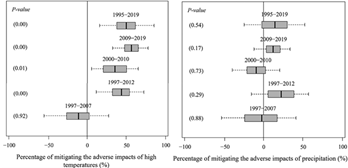China's Grain Production: Adaptation Levels and Mechanisms to Climate Change
Published 24 June, 2025
The increasing risks of climate change have introduced numerous latent perils to China's food security and agricultural production, highlighting between the realities of climate change and the requirement for stable and high agricultural yields. In a study published in the KeAi journal China Economic Quarterly International, researchers Liu Dong, Feng Xiaolong, and Si Wei estimated the overall adaptation level and mechanisms of grain production to climate change in China.
"Adaptive behaviors have alleviated 52.5 %– 63.5 % of the adverse impacts of high temperatures, with rice and maize more adaptable than wheat,” explains Liu. “However, adaptive behavior has not effectively mitigated excessive precipitation impacts."
The researchers used national rural fixed observation points data, the long differences method, and a two-way fixed-effects model to systematically assess the adaptation level. “We found differences in adaptation levels among different crops,” shares Feng. “Rice and maize are more adaptable to high temperatures than wheat.”
Differences in adaptation levels were also identified. Grain production in the northern region is more adaptable to high temperatures than that in the southern region. "This suggests that though grain production in southern regions suffers less from high temperatures in the short term, it also shows a low adaptation level," adds Feng.
Technological progress, adaptation technology adoption, and input adjustments are found to be key adaptation mechanisms. For example, technological progress can mitigate 31.8 % of the adverse impacts of high temperatures on grain production. From a micro-household perspective, the adoption of conservation tillage can significantly mitigate the adverse impacts of high temperatures on grain yield per mu, especially for wheat and maize.
“We should recognize the severity of the adverse impacts of excessive precipitation on grain production and the urgent need to enhance the adaptation level,” says Si. “Improving agricultural infrastructure and water resource management is essential."
The researchers hope that their findings can provide valuable insights for improving and implementing national climate change adaptation strategies and policies, thereby enhancing the resilience of grain production to climate risks.

Contact author: Si Wei, College of Economics and Management, China Agricultural University, No.17, Qinghua East Road, Haidian District, Beijing, 100083, China, siwei@cau.edu.cn.
Funder: This article was funded by the “China Agriculture Research System-Soybean(CARS-04-04A), the project of the National Natural Science Foundation of China titled “Research on Herdsmen's Behavioral Responses and Development Resilience to Extreme Climate Events: From the Perspective of Support Policies” (72373145), and the International (Regional) Cooperation and Exchange Project of the National Natural Science Foundation of China “Optimizing China's Agricultural Subsidies to Promote the Transformation of the Agricultural Food System in the Global Context” (72061147002).
Conflict of interest: The authors declare that they have no known competing financial interests or personal relationships that could have appeared to influence the work reported in this paper.
See the article: Liu, D., Feng, X., Si, W., 2025. The Adaptation Level and Mechanism of Grain Production to Climate Change in China. China Economic Quarterly International. 5(1): 1-22. https://doi.org/10.1016/j.ceqi.2025.03.001